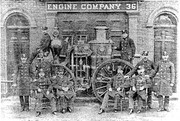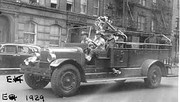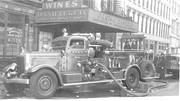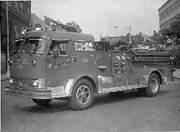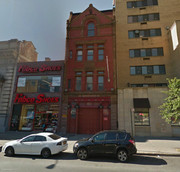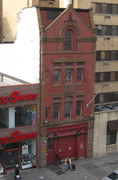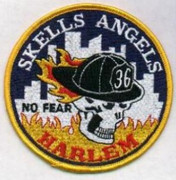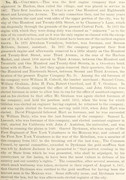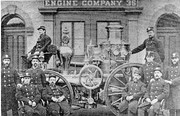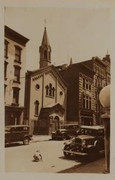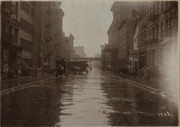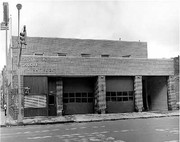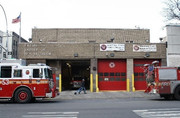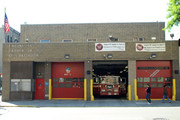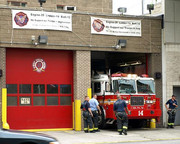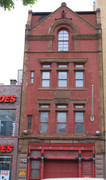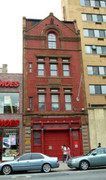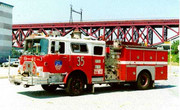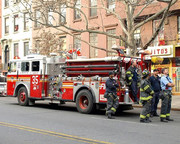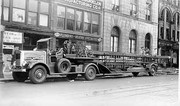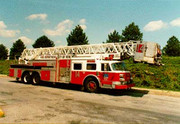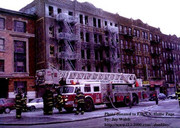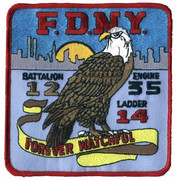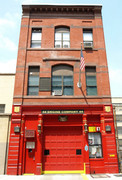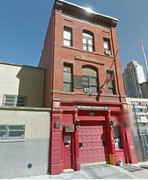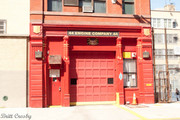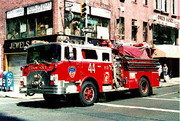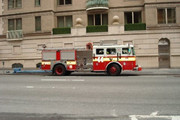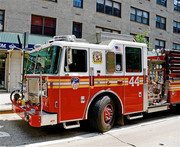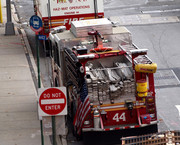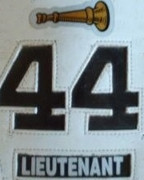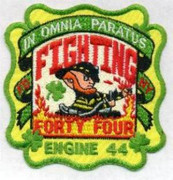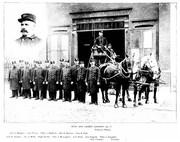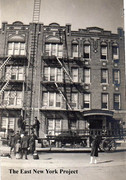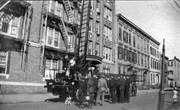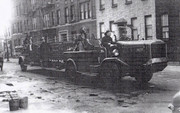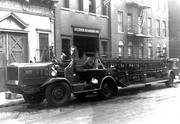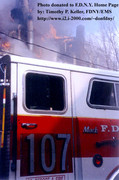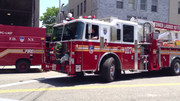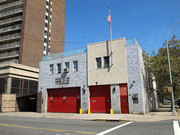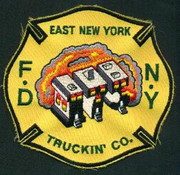Harlem - origin of Collyers' Mansion Condition
Harlem was the location of a brownstone at 2078 5th Avenue, occupied by 2 brothers, Homer Lusk Collyer (1881?1947) and Langley Wakeman Collyer (1885?1947), who became famous because of their bizarre natures and compulsive hoarding. Their Harlem home originated the firefighting term "Colliers' Mansion Condition" for a dwelling of hoarders that is so filled with trash and debris it becomes a serious danger to the occupants and emergency responders.
For decades, the rarely seen brothers obsessively collected books, furniture, musical instruments, and many other items, with booby traps set up in corridors and doorways to ensnare intruders. Both were eventually found dead in the Harlem brownstone where they had lived, surrounded by over 140 tons of collected items that they had amassed over several decades.
History:
The Collyer brothers were sons of Herman Livingston Collyer, a Manhattan gynecologist and Susie Gage Frost, an opera singer. Their parents were first cousins. The brothers would later claim that their ancestors had traveled to America from England on the Speedwell, the ship that arrived in Massachusetts a week after the Mayflower in 1620.
Both Homer and Langley attended Columbia University. Homer obtained a degree in law, while Langley studied engineering and chemistry. Langley was an accomplished concert pianist and played professionally at Carnegie Hall. Langley was also a layman of the Trinity Church where the family had been parishioners since 1697.
In 1909, their father, Dr. Herman Collyer, moved the family into the four-story brownstone in Harlem. Dr. Collyer was known to be eccentric himself and frequently paddled down the East River in a canoe to the City Hospital on Blackwell's Island, where he worked, and then carried the canoe back to his home in Harlem after he came ashore on Manhattan Island. Around 1919, their parents separated. Homer and Langley, who had never married or lived on their own, remained with their mother in her Harlem brownstone.
After their parents' deaths, the Collyer brothers continued to live together in the Harlem brownstone they inherited from their mother. During this time, they socialized normally and left their home on a regular basis. Homer continued to practice law while Langley worked as a piano dealer. In 1933, Homer lost his eyesight due to hemorrhages in the back of his eyes. Langley quit his job to care for his brother and the two began to withdraw from society.
As time progressed, the brothers became fearful due to demographic changes in the neighborhood. The largely white, upper-class neighborhood went into decline during the Great Depression. Crime and poverty rates increased and more African Americans moved into the once empty apartment houses that were built near a projected subway route. When asked why the two chose to shut themselves off from the world, Langley Collyer replied, "We don't want to be bothered." As rumors about the brothers' unconventional lifestyle spread throughout Harlem and crowds began to congregate outside their home, the brothers' fears increased as did their eccentricities. They boarded up the windows of their brownstone after teenagers threw rocks at their windows and wired the doors shut. After a number of attempted burglaries due to unfounded rumors that the brothers' home contained valuables and large sums of money, Langley set about using his engineering skills to set up booby traps and tunnels among the collection of items and garbage that filled the house. The house soon became a maze of boxes, complicated tunnel systems rigged with trip wires and various amounts of junk and garbage. Homer and Langley Collyer lived among the items in "nests" created amongst the debris that was piled to the ceiling.
Langley spent the majority of his time tinkering with various inventions, such as a device to vacuum the insides of pianos and a Model T Ford adapted to generate electricity. He also cared for his brother Homer. Langley later told a reporter that he fed and bathed his brother, read him classic literature as he could no longer see and played piano sonatas for him. He also tended to Homer's health and was determined to cure his brother's physical ailments through "diet and rest". Langley concocted a diet consisting of one hundred oranges a week, black bread and peanut butter that he claimed was curing Homer's blindness. After Homer became paralyzed due to inflammatory rheumatism, he refused to seek professional medical treatment because both brothers mistrusted doctors. Langley stated that if Homer sought medical attention, doctors would cut his optic nerve which would leave him permanently blind and they would give Homer drugs that would certainly hasten his death. Langley Collyer later told a reporter, "You must remember that we are the sons of a doctor. We have a medical library of 15,000 books in the house. We decided we would not call in any doctors. You see, we knew too much about medicine."
Langley began venturing out of the house only after midnight and would walk miles all over the city to get food, sometimes going as far as Williamsburg, Brooklyn to buy as little as a loaf of bread. He would also pick food out of the garbage and collect food that was going to be thrown out by grocers and butchers to bring back to his brother Homer. He also collected countless pieces of abandoned items and trash that aroused his interest.
By the early 1930s, the Collyer brothers' brownstone had fallen into disrepair. Their telephone was disconnected in 1917 and never reconnected as the brothers said they had no one to talk to. Because the brothers failed to pay their bills, the electricity, water, and gas were turned off in 1928. The brothers took to warming the large house using only a small kerosene heater. For a while, Langley attempted to generate his own energy by means of a car engine. Langley would fetch their water from a pump in nearby parks. Their only link to the outside world was via a crystal radio that Langley made.
Neighbors and shopkeepers in the area described Langley Collyer as a generally polite and rational man but added that he was "crazy". A reporter who interviewed Langley in 1942 described him as a "soft spoken old gentleman with a liking for privacy" who spoke in a "low, polite and cultivated voice." His appearance was disheveled; he sported a droopy mustache, wore a 1910 boating cap and his tattered clothes were held together by pins. While Langley Collyer ventured out of the home and occasionally interacted with other people, Homer had not been seen or heard from since he went blind in 1933 and retreated from the world. Langley was fiercely protective of Homer and would not allow anyone to see him. When he caught neighbors attempting to peek into their windows from a neighboring home, Langley bought the property for $7,500 cash. When a small fire broke out in the home in 1941, Langley refused to let fireman see or speak to his brother.
In 1932, shortly before Homer Collyer went blind, he purchased the property across the street from their house at 2077 Fifth Avenue, with the intent of developing it by putting up an apartment building. But after the onset of his blindness, any plans of profit from the real estate venture fell through. Since the Collyer brothers never paid any of their bills and stopped paying income taxes in 1931, the property was repossessed by the City of New York in 1943 to pay the $1,900 in back income taxes that the Collyers owed the city. Langley protested the repossession of their property, saying that since they had no income, they should not have to pay income taxes.
While rumors and legends abounded in Harlem about the brothers, they came to wider attention when, in 1938, a story about their refusal to sell their home to a real estate agent for $125,000 appeared in The New York Times. The Times repeated information about the brothers' hoarding and also repeated neighborhood rumors that the brothers lived in some sort of "Orientalist splendor" and were sitting on vast piles of cash, afraid to deposit it in a bank. Neither rumor was true; the brothers were certainly not broke, although eventually they would have been, since neither of them had worked for decades. Langley explained that he dressed in shabby clothing because, "They would rob me if I didn't.
The Collyer brothers made the news again when, in 1939, workers from Consolidated Edison forced their way into the house to remove two gas meters that had been shut off in 1928. The incident reportedly drew a crowd of 1,000 curious onlookers. They drew media attention again in 1942 when they got in trouble with the bank after refusing to pay the mortgage on their house. That same year, the New York Herald Tribune interviewed Langley. In response to a query about the bundles of newspapers that were kept in the brothers' home, Langley replied, "I am saving newspapers for Homer, so that when he regains his sight he can catch up on the news."
When the Bowery Savings Bank began eviction procedures, they sent over a cleanup crew. Langley began yelling at the workers prompting the neighbors to summon the police. When the police attempted to force their way in to the home by smashing down the front door, they were stymied by a sheer wall of junk piled from floor to ceiling. They found Langley Collyer in a clearing he made in the middles of the debris. Without comment, Langley made out a check for $6,700 (2014 equivalent of $96,707, paying off the mortgage in full in a single payment. He then ordered everyone off the premises, and withdrew from outside scrutiny once more, emerging only at night and when he wanted to file criminal complaints against intruders, get food or collect items that piqued his interest.
On March 21, 1947, an anonymous tipster who identified himself only as "Charles Smith" phoned the 122nd Police Precinct and insisted there was a dead body in the house. The caller claimed that the smell of decomposition was emanating from the house. As the police were used to calls from neighbors about the Collyer brothers' home, a patrol officer was dispatched. The responding officer initially had a difficult time getting into the house. There was no doorbell nor telephone and the doors were locked; and though the basement windows were broken, they were protected by iron grillwork. An emergency squad of seven men eventually had no choice but to begin pulling out all the junk that was blocking their way and throwing it out onto the street below. The brownstone's foyer was packed solid by a wall of old newspapers, folding beds and chairs, half a sewing machine, boxes, parts of a wine press, and numerous other pieces of junk. A patrolman finally broke in through a window into a second-story bedroom. Behind this window lay, among other things, more packages and newspaper bundles, empty cardboard boxes lashed together with rope, the frame of a baby carriage, a rake, and old umbrellas tied together. After five hours of digging, Homer Collyer's body was found in an alcove surrounded by filled boxes and newspapers that were piled to the ceiling. Homer was wearing a tattered blue-and-white bathrobe, his matted, grey hair reached his shoulders, and his head was resting on his knees.
The medical examiner confirmed Homer's identity and said that the elder brother had been dead for approximately ten hours. According to the medical examiner, Homer died from starvation and heart disease. Police initially suspected that Langley Collyer was the man who phoned in the anonymous tip regarding his brother's death and theorized that he fled the house before police arrived (it was later discovered that a neighbor called police based on a rumor he heard). A police officer was posted outside the home to wait for Langley but he never arrived. Police began to suspect that Langley was dead when he failed to attend Homer's funeral held on April 1.
On March 30, false rumors circulated that Langley had been seen aboard a bus heading for Atlantic City. A manhunt along the New Jersey shore turned up nothing. Reports of Langley sightings led police to a total of nine states. The police continued searching the house two days later, removing 3,000 books, several outdated phone books, a horse's jawbone, a Steinway piano, an early X-ray machine, and more bundles of newspapers. More than nineteen tons of junk was removed from the ground floor of the brownstone. The police continued to clear away the brothers' stockpile for another week, removing another eighty-four tons of rubbish from the house. Although a good deal of the junk came from their father's medical practice, a considerable portion was discarded items collected by Langley over the years. Approximately 2,000 people stood outside the home to watch the clean up effort.
On April 8, 1947, a workman found the body of Langley Collyer ten feet from where Homer had died. Langley was found in a two-foot wide tunnel lined with rusty bed springs and a chest of drawers. His decomposing body, which was the actual source of the smell reported by the anonymous tipster, had been partially eaten by rats and was covered by a suitcase, bundles of newspapers and three metal bread boxes. The medical examiner determined that Langley had died around March 9. Police theorized that Langley was crawling through the tunnel to bring food to his paralyzed brother when he inadvertently tripped the booby trap he created and was crushed by debris. His cause of death was attributed to asphyxiation.
Both brothers were buried next to their parents in unmarked graves at Cypress Hills Cemetery, Brookly
Police and workmen removed approximately 120 tons of garbage from the Collyer brownstone. Items were removed from the house such as baby carriages, a doll carriage, rusted bicycles, old food, potato peelers, a collection of guns, glass chandeliers, bowling balls, camera equipment, the folding top of a horse-drawn carriage, a sawhorse, three dressmaking dummies, painted portraits, photos of pinup girls from the early 1900s, plaster busts, Mrs. Collyer's hope chests, rusty bed springs, the kerosene stove, a child's chair (the brothers were lifelong bachelors and childless), more than 25,000 books (including thousands about medicine and engineering and more than 2,500 on law), human organs pickled in jars, eight live cats, the chassis of the old Model T with which Langley had been tinkering, tapestries, hundreds of yards of unused silks and other fabrics, clocks, fourteen pianos (both grand and upright), a clavichord, two organs, banjos, violins, bugles, accordions, a gramophone and records, and countless bundles of newspapers and magazines, some of them decades old, and thousands of bottles and tin cans and a great deal of garbage. Near the spot where Homer had died, police also found 34 bank account passbooks, with a total of $3,007 (about $36,366 as of 2014).
Some of the more unusual items found in the home were exhibited at Hubert's Dime Museum, where they were featured alongside Human Marvels and sideshow performers. The centerpiece of this display was the chair in which Homer Collyer had died. The Collyer chair passed into the hands of private collectors upon being removed from public exhibit in 1956.
The house itself, having long gone without maintenance, was decaying: the roof leaked and some walls had caved in, showering bricks and mortar on the rooms below. The house was deemed "unsafe and a fire hazard" in July 1947 and was razed.
Most of the items found in the Collyer brothers' house were deemed worthless and were disposed of. The salvageable items fetched less than $2,000 at auction; the cumulative estate of the Collyer brothers was valued at $91,000, of which $20,000 worth was personal property (jewelry, cash, securities, and the like). Fifty six people, mostly first and second cousins, made claims for the estate. A Pittsburgh woman named Ella Davis claimed to be the long lost sister of the Collyers'. Davis' claim was dismissed after she failed to provide a birth certificate to prove her identity (Years earlier, Davis claimed she was the widow of Peter Liebach, another wealthy New York City recluse who was found murdered in 1937). In October 1952, the New York County court decided that 23 of the claimants were to split the estate equally.
Legacy: Since the 1960s, the site of the former Collyer house has been a pocket park, named for the brothers. A Collyer's Mansion (also Collyer Mansion or just Collyer) is a modern firefighting term for a dwelling of hoarders that is so filled with trash and debris it becomes a serious danger to the occupants and emergency responders.
From Wikipedia
https://www.youtube.com/watch?v=VqCoC3ChXdg
http://en.wikipedia.org/wiki/Collyer_brothers
